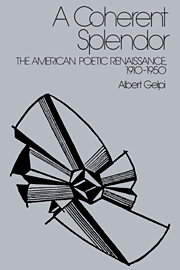Book contents
- Frontmatter
- Contents
- Acknowledgments
- Dedication
- Introduction. The Janus-Face of Romanticism and Modernism
- 1 Robert Frost and John Crowe Ransom: Diptych of Ironists, the Woodsman and the Chevalier
- 2 Wallace Stevens: World as Mundo, Mundo as World
- 3 T. S. Eliot: The Lady Between the Yew Trees
- 4 Ezra Pound: Between Kung and Elcusis
- 5 H. D.: Helen in Bethlehem, Hilda in Egypt
- 6 William Carlos Williams: Mother-Son and Paterson
- 7 Allen Tate and Hart Crane: Diptych with Angels and Demons
- Coda. Yvor Winters and Robinson Jeffers: The Janus-Face of Anti-Modernism
- Notes
- Index
Introduction. The Janus-Face of Romanticism and Modernism
Published online by Cambridge University Press: 22 January 2010
- Frontmatter
- Contents
- Acknowledgments
- Dedication
- Introduction. The Janus-Face of Romanticism and Modernism
- 1 Robert Frost and John Crowe Ransom: Diptych of Ironists, the Woodsman and the Chevalier
- 2 Wallace Stevens: World as Mundo, Mundo as World
- 3 T. S. Eliot: The Lady Between the Yew Trees
- 4 Ezra Pound: Between Kung and Elcusis
- 5 H. D.: Helen in Bethlehem, Hilda in Egypt
- 6 William Carlos Williams: Mother-Son and Paterson
- 7 Allen Tate and Hart Crane: Diptych with Angels and Demons
- Coda. Yvor Winters and Robinson Jeffers: The Janus-Face of Anti-Modernism
- Notes
- Index
Summary
but gods always face two-ways.…
H. D., The Walls Do Not FallA Coherent Splendor is a companion volume to The Tenth Muse (1975). Although each book has its own integrity, together they comprise a single extensive essay on the American poetic tradition. The Tenth Muse traced the development of American Romantic poetry both out of and against its Calvinist source through chapters on five poets – Edward Taylor, Ralph Waldo Emerson, Edgar Allan Poe, Walt Whitman, and Emily Dickinson. A Coherent Splendor traces the development of American Modernist poetry both out of and against American Romanticism by focusing on a range of poets from that astonishing generation born in the final decades of the nineteenth century and coming to poetic maturity in the years just before and after World War I: Robert Frost, John Crowe Ransom, Wallace Stevens, T. S. Eliot, Ezra Pound, H. D., William Carlos Williams, Allen Tate, Hart Crane, Yvor Winters, Robinson Jeffers.
What distinguishes these two books from such excellent earlier studies as Roy Harvey Pearce's Continuity of American Poetry and Hyatt Waggoner's American Poets is the mounting of a literary-historical argument through the extended and detailed study of major representatives. The chapters aim at something of the comprehensiveness and depth of a monograph on the individual poets, while locating them in the broader cultural landscape. As in The Tenth Muse, then, my purpose here is double, at once historical and interpretive: to substantiate the argument about the tradition through detailed readings of important poems of the first half of this century.
- Type
- Chapter
- Information
- A Coherent SplendorThe American Poetic Renaissance, 1910–1950, pp. 1 - 7Publisher: Cambridge University PressPrint publication year: 1988



